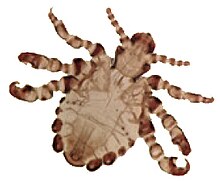Pthirus gorillae or gorilla louse is a species of parasitic sucking louse that afflicts gorillas.[1] It is found in the African continent, specifically in Rwanda and Democratic Republic of the Congo.[2] P. gorillae and P. pubis (the crab louse) are the only known species that belong to the genus Pthirus, often incorrectly spelled as Phthirus (the Greek word for louse is phthir).[3] It is suggested that it is transmitted among its hosts by social grooming, shared bedding and sexual contact.[4]
| Pthirus gorillae | |
|---|---|
 | |
| A magnified image of Pthirus gorillae | |
| Scientific classification | |
| Domain: | Eukaryota |
| Kingdom: | Animalia |
| Phylum: | Arthropoda |
| Class: | Insecta |
| Order: | Psocodea |
| Family: | Pthiridae |
| Genus: | Pthirus |
| Species: | P. gorillae |
| Binomial name | |
| Pthirus gorillae Ewing, 1927 | |
All species of sucking lice feed on blood.[5] They live in close association with their hosts and complete their entire life cycle on the host.[1] Pthirus gorillae infests the same parts of the bodies of gorillas as Pthirus pubis does in humans,[6] but since the gorilla is hairier, the lice tend to range over the whole body.[7] The two also resemble each other with the exception that Pthirus gorillae has large eyes that are placed on large lateral protuberances. A short and broad sucking louse, it is about 2.20 mm long with sprawling legs and not more than 20 small abdominal setae.[4]
It was first identified from specimens of mountain gorillas in 1927 by Henry Ellsworth Ewing during a game-hunting trip in what is now the Democratic Republic of the Congo.[4] Molecular phylogenetics suggest that P. gorillae jumped from gorillas to early humans 3.3 million years ago and diverged into the present-day pubic louse.[1][8] Researchers theorize that humans acquired the parasite while butchering or scavenging on gorilla carcasses, or sleeping in the abandoned sleeping nests of gorillas.[9][10]
Several lice of the species were found during a necropsy in the stomach of a female gorilla from Bwindi Impenetrable National Park; she had presumably been grooming before she died.[4]
The conservation status of this species is unknown. Since its host species is critically endangered, it is likely that this species is endangered too.
References
External links
- Apes, lice and prehistory by Robin A Weiss
- Genetic Analysis of Lice Supports Direct Contact between Modern and Archaic Humans by David L. Reed et al.